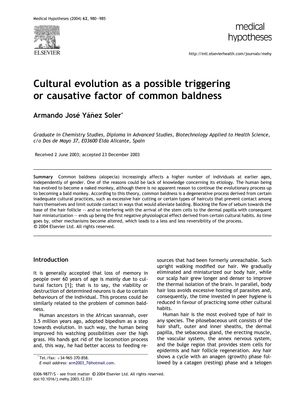TLDR Certain cultural hair practices might cause baldness by affecting natural hair oils and stem cell delivery to hair follicles.
In the 2004 paper by Armando José Yáñez Soler, it was hypothesized that cultural practices such as excessive hair cutting and certain hairstyles might trigger or cause common baldness by blocking sebum flow and interfering with stem cell delivery to the hair follicle. This could lead to hair miniaturization and a degenerative process that becomes less reversible over time. The paper suggested that individuals with short, thin, or straight hair are more susceptible to baldness, while those with long, thick, or curly hair, and certain ethnicities with long hair traditions, are less affected. The hypothesis was supported by observations like the efficacy of tonsure in producing localized baldness and the inability to induce baldness where sebum flow is unobstructed. The author proposed that maintaining longer hair could prevent baldness by allowing outward sebum flow, but once baldness has occurred, it is difficult to reverse. The paper called for further research into the relationship between sebum flow, hair follicle health, and stem cell transport, emphasizing prevention over treatment and suggesting that cultural practices could be modified to prevent common baldness.
 24 citations
,
September 2002 in “Dermatologic Surgery”
24 citations
,
September 2002 in “Dermatologic Surgery” The place where hair is transplanted can affect its growth and survival rates.
 157 citations
,
July 2001 in “British Journal of Dermatology”
157 citations
,
July 2001 in “British Journal of Dermatology” AGA more common in men, Koreans have lower rates and unique patterns.
169 citations
,
June 1998 in “Journal of Investigative Dermatology” Male pattern baldness is likely caused by multiple genes, not just 5α-reductase genes.
 35 citations
,
January 2020 in “Skin Pharmacology and Physiology”
35 citations
,
January 2020 in “Skin Pharmacology and Physiology” The review concluded that keeping the hair-growing ability of human dermal papilla cells is key for hair development and growth.
 29 citations
,
October 2011 in “British Journal of Dermatology”
29 citations
,
October 2011 in “British Journal of Dermatology” Certain microRNAs are more common in balding areas and might be involved in male pattern baldness.
 3 citations
,
April 2010 in “Endocrinology”
3 citations
,
April 2010 in “Endocrinology” The mouse model suggests male pattern baldness may be due to an enzyme increasing DHT and higher androgen receptor levels in hair follicles.
January 2010 in “International Journal of Dermatology and Venereology” Dermal papilla cells play a key role in hair loss by responding to androgens.
8 citations
,
February 2009 in “Journal of Dermatological Science”  1 citations
,
November 2002 in “Neurosurgery Clinics of North America”
1 citations
,
November 2002 in “Neurosurgery Clinics of North America” The article concludes that cranial reconstruction should aim for the best aesthetic result, using various techniques tailored to individual needs and conditions.
 September 1998 in “Journal of the European Academy of Dermatology and Venereology”
September 1998 in “Journal of the European Academy of Dermatology and Venereology” Autoimmune and inflammatory processes are involved in both scarring and non-scarring types of hair loss.

Different hair growth phases affect how follicles respond to X-rays, and hormones like testosterone and dihydrotestosterone play a key role in baldness; transplanted hair can grow on bald scalp areas.









